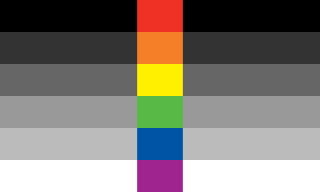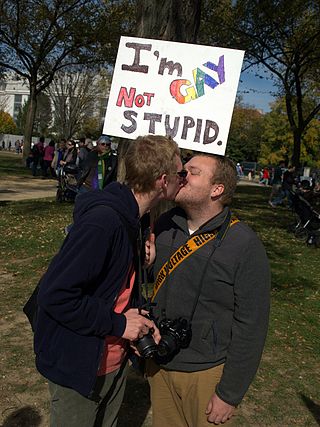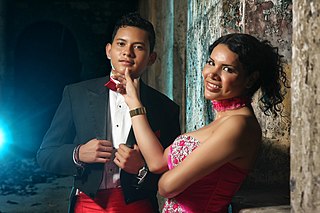Related Research Articles

Heterosexuality is romantic attraction, sexual attraction or sexual behavior between people of the opposite sex or gender. As a sexual orientation, heterosexuality is "an enduring pattern of emotional, romantic, and/or sexual attractions" to people of the opposite sex; it "also refers to a person's sense of identity based on those attractions, related behaviors, and membership in a community of others who share those attractions." Someone who is heterosexual is commonly referred to as straight.

A lesbian is a homosexual woman or girl. The word is also used for women in relation to their sexual identity or sexual behavior, regardless of sexual orientation, or as an adjective to characterize or associate nouns with female homosexuality or same-sex attraction. The concept of "lesbian" to differentiate women with a shared sexual orientation evolved in the 20th century. Throughout history, women have not had the same freedom or independence as men to pursue homosexual relationships, but neither have they met the same harsh punishment as gay men in some societies. Instead, lesbian relationships have often been regarded as harmless, unless a participant attempts to assert privileges traditionally enjoyed by men. As a result, little in history was documented to give an accurate description of how female homosexuality was expressed. When early sexologists in the late 19th century began to categorize and describe homosexual behavior, hampered by a lack of knowledge about homosexuality or women's sexuality, they distinguished lesbians as women who did not adhere to female gender roles. They classified them as mentally ill—a designation which has been reversed since the late 20th century in the global scientific community.

Sexual orientation is an enduring personal pattern of romantic attraction or sexual attraction to persons of the opposite sex or gender, the same sex or gender, or to both sexes or more than one gender. Patterns are generally categorized under heterosexuality, homosexuality, and bisexuality, while asexuality is sometimes identified as the fourth category.

Bi-curious is a term for a person, usually someone who is a self-identified heterosexual, who is curious or open about engaging in sexual activity with a person whose sex differs from that of their usual sexual partners. The term is sometimes used to describe a broad continuum of sexual orientation between heterosexuality and bisexuality. Such continuums include mostly heterosexual or mostly homosexual, but these can be self-identified without identifying as bisexual. The terms heteroflexible and homoflexible are mainly applied to bi-curious people, though some authors distinguish heteroflexibility and homoflexibility as lacking the "wish to experiment with sexuality" implied by the bi-curious label. It is important when discussing this continuum to conclude that bisexuality is distinct from heterosexuality and homosexuality rather than simply an extension of said sexualities like the labels heteroflexibility and homoflexibility would imply, due to the prominent erasure and assimilation of bisexuality into other identity groups. To sum it up, the difference between bisexual and bicurious is that bisexual people know that they are sexually attracted to both genders based on personal experience. Bicurious people are still maneuvering their way through their sexuality.

The Kinsey scale, also called the Heterosexual–Homosexual Rating Scale, is used in research to describe a person's sexual orientation based on one's experience or response at a given time. The scale typically ranges from 0, meaning exclusively heterosexual, to a 6, meaning exclusively homosexual. In both the male and female volumes of the Kinsey Reports, an additional grade, listed as "X", indicated "no socio-sexual contacts or reactions" (asexuality). The reports were first published in Sexual Behavior in the Human Male (1948) by Alfred Kinsey, Wardell Pomeroy, and others, and were also prominent in the complementary work Sexual Behavior in the Human Female (1953).

Biphobia is aversion toward bisexuality or people who are identified or perceived as being bisexual. Similarly to homophobia, it refers to hatred and prejudice specifically against those identified or perceived as being in the bisexual community. It can take the form of denial that bisexuality is a genuine sexual orientation, or of negative stereotypes about people who are bisexual. Other forms of biphobia include bisexual erasure.
Heterosexism is a system of attitudes, bias, and discrimination in favor of heterosexuality and heterosexual relationships. According to Elizabeth Cramer, it can include the belief that all people are or should be heterosexual and that heterosexual relationships are the only norm and therefore superior.

The field of psychology has extensively studied homosexuality as a human sexual orientation. The American Psychiatric Association listed homosexuality in the DSM-I in 1952, but that classification came under scrutiny in research funded by the National Institute of Mental Health. That research and subsequent studies consistently failed to produce any empirical or scientific basis for regarding homosexuality as anything other than a natural and normal sexual orientation that is a healthy and positive expression of human sexuality. As a result of this scientific research, the American Psychiatric Association removed homosexuality from the DSM-II in 1973. Upon a thorough review of the scientific data, the American Psychological Association followed in 1975 and also called on all mental health professionals to take the lead in "removing the stigma of mental illness that has long been associated" with homosexuality. In 1993, the National Association of Social Workers adopted the same position as the American Psychiatric Association and the American Psychological Association, in recognition of scientific evidence. The World Health Organization, which listed homosexuality in the ICD-9 in 1977, removed homosexuality from the ICD-10 which was endorsed by the 43rd World Health Assembly on 17 May 1990.
Sexual identity refers to one's self-perception in terms of romantic or sexual attraction towards others, though not mutually exclusive, and can be different to romantic identity. Sexual identity may also refer to sexual orientation identity, which is when people identify or dis-identify with a sexual orientation or choose not to identify with a sexual orientation. Sexual identity and sexual behavior are closely related to sexual orientation, but they are distinguished, with identity referring to an individual's conception of themselves, behavior referring to actual sexual acts performed by the individual, and sexual orientation referring to romantic or sexual attractions toward persons of the opposite sex or gender, the same sex or gender, to both sexes or more than one gender, or to no one.

Non-heterosexual is a word for a sexual orientation or sexual identity that is not heterosexual. The term helps define the "concept of what is the norm and how a particular group is different from that norm". Non-heterosexual is used in feminist and gender studies fields as well as general academic literature to help differentiate between sexual identities chosen, prescribed and simply assumed, with varying understanding of implications of those sexual identities. The term is similar to queer, though less politically charged and more clinical; queer generally refers to being non-normative and non-heterosexual. Some view the term as being contentious and pejorative as it "labels people against the perceived norm of heterosexuality, thus reinforcing heteronormativity". Still, others say non-heterosexual is the only term useful to maintaining coherence in research and suggest it "highlights a shortcoming in our language around sexual identity"; for instance, its use can enable bisexual erasure.

Heteroflexibility is a form of a sexual orientation or situational sexual behavior characterized by minimal homosexual activity in an otherwise primarily heterosexual orientation, which may or may not distinguish it from bisexuality. It has been characterized as "mostly straight". Although sometimes equated with bi-curiosity to describe a broad continuum of sexual orientation between heterosexuality and bisexuality, other authors distinguish heteroflexibility as lacking the "wish to experiment with ... sexuality" implied by the bi-curious label. The corresponding situation in which homosexual activity predominates has also been described, termed homoflexibility.

Obtaining precise numbers on the demographics of sexual orientation is difficult for a variety of reasons, including the nature of the research questions. Most of the studies on sexual orientation rely on self-reported data, which may pose challenges to researchers because of the subject matter's sensitivity. The studies tend to pose two sets of questions. One set examines self-report data of same-sex sexual experiences and attractions, while the other set examines self-report data of personal identification as homosexual or bisexual. Overall, fewer research subjects identify as homosexual or bisexual than report having had sexual experiences or attraction to a person of the same sex. Survey type, questions and survey setting may affect the respondents' answers.

Terms used to describe homosexuality have gone through many changes since the emergence of the first terms in the mid-19th century. In English, some terms in widespread use have been sodomite, Achillean, Sapphic, Uranian, homophile, lesbian, gay, effeminate, queer, homoaffective, and same-gender attracted. Some of these words are specific to women, some to men, and some can be used of either. Gay people may also be identified under the umbrella term LGBT.

Sexual attraction to transgender people has been the subject of scientific study and social commentary. Psychologists have researched sexual attraction toward trans women, trans men, cross dressers, non-binary people, and a combination of these. Publications in the field of transgender studies have investigated the attraction transgender individuals can feel for each other. The people who feel this attraction to transgender people name their attraction in different ways.

LGBT stereotypes are stereotypes about lesbian, gay, bisexual and transgender (LGBT) people are based on their sexual orientations, gender identities, or gender expressions. Stereotypical perceptions may be acquired through interactions with parents, teachers, peers and mass media, or, more generally, through a lack of firsthand familiarity, resulting in an increased reliance on generalizations.

Homosexuality is a sexual attraction, romantic attraction, or sexual behavior between members of the same sex or gender. As a sexual orientation, homosexuality is "an enduring pattern of emotional, romantic, and/or sexual attractions" exclusively to people of the same sex or gender. It "also refers to a person's sense of identity based on those attractions, related behaviors, and membership in a community of others who share those attractions."

Bisexual erasure, also called bisexual invisibility, is the tendency to ignore, remove, falsify, or re-explain evidence of bisexuality in history, academia, the news media, and other primary sources.
A mixed-orientation marriage is a marriage between partners of differing sexual orientations. The broader term is mixed-orientation relationship, sometimes shortened to MOR or MORE.

Bisexuality is a romantic or sexual attraction or behavior toward both males and females, to more than one gender, or to both people of the same gender and different genders. It may also be defined to include romantic or sexual attraction to people regardless of their sex or gender identity, which is also known as pansexuality.

Compulsory heterosexuality, often shortened to comphet, is the theory that heterosexuality is assumed and enforced upon people by a patriarchal and heteronormative society. The term was popularized by Adrienne Rich in her 1980 essay titled "Compulsory Heterosexuality and Lesbian Existence". According to Rich, social science and literature perpetuate the societal belief that women in every culture are believed to have an innate preference for romantic and sexual relationships with men. She argues that women's sexuality towards men is not always natural but is societally ingrained and scripted into women. Comphet creates the belief that society is overwhelmingly heterosexual and delegitimizes queer identities. As a result, it perpetuates homophobia and legal inequity for the LGBTQ+ community.
References
- ↑ Zhana Vrangalova, Ph.D., September 27, 2014, Psychology Today, Strictly Casual: What research tells us about the whos, whys, and hows of hookups, Retrieved Oct. 2, 2014, "...or monosexuality (attraction to only one sex)...."
- 1 2 Hamilton, Alan (16 December 2000). "Monosexual". LesBiGay and Transgender Glossary. Bisexual Resource Center. Archived from the original on August 5, 2007. Retrieved 8 September 2012.
- ↑ May 22, 2014 by Samantha Joel, M.A., Psychology Today, Three Myths About Bisexuality, Debunked by Science: First of all, it's not a college phase, Retrieved Oct. 2, 2014, "...better understand the ways in which bisexuality is similar to monosexual (heterosexual, gay, lesbian) identities ...."
- ↑ Sheff, Elisabeth (2005). "Polyamorous Women, Sexual Subjectivity and Power". Journal of Contemporary Ethnography. 34 (3): 251–283. doi:10.1177/0891241604274263. S2CID 146123953.
...Dylan's relationships with men and women each had distinct qualities that she felt a monosexual relationship could not hope to satisfy...
- ↑ Sanoff, Rachel (1 June 2016). "What Does It Mean To Be Monosexual?". Bustle. Retrieved 28 December 2022.